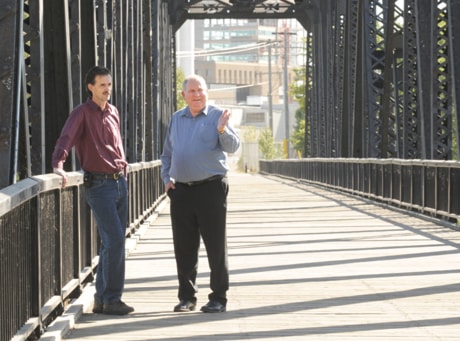Building safe communities requires the combined efforts of city councils, police, business and residents, says an official with an international crime prevention organization.
Tony Lake, director of international operations for the group Crime Prevention Through Environmental Design (CPTED), was in Red Deer Tuesday touring the city’s efforts to build a safer community.
A policeman for 36 years in the Australian state of Queensland and now an advisor with an international security and crime prevention firm, Lake said Red Deer is well on the road to ensuring safety for everyone because of the co-operation between various agencies.
Based in Brisbane, the capital of Queensland, Lake said he dropped into Red Deer at the invitation of Steve Woolrich who is a consultant for the City of Red Deer assisting with ideas through environmental design to enhance safety.
Woolrich, who runs SeCure Consulting Solutions, said improving safety involves “good design principles and incorporating them” in construction.
Lake said that one of his final duties as a ranking policeman was designing CPTED guidelines for Queensland.
He said CPTED is “not the be all and end all, it’s just one of the things you can use.”
He said it’s important for communities to have regular round table discussions to improve safety.
Woolrich said in Red Deer it was important “to tie in the social component because that’s a huge part of the success story.”
He said groups such as Neighbourhood Watch, Citizens on Patrol and representatives of people working with youth and high-risk groups as well as the police are vital for the concept to succeed.
Lake said he runs workshops in New Zealand which is “really taking to the concept,” of Crime Prevention Through Environmental Design.
He also said it’s vital that governments adopt CPTED guidelines. This has occurred in Queensland.
Woolrich said Red Deer adopted guidelines through its land-use bylaw a few years ago.
Lake’s first stop was at a neighbourhood in Deer Park where he was impressed by a group of residents who have built wrought iron fences to improve their sightlines to a park.
Lake said not only can the residents see what is going on behind them, a see-through fence prevents people from drawing graffiti on them.
He said new neighbourhoods tend to create private walkways in the back of them, which makes it easy for people bent on creating mischief to succeed.
He said developers build typical wooden fences that shut neighbours off from one another and prevent vision to access points in their rear.
“It gives you more ownership of what’s happening in the backyard,” Lake said.
He said natural ownership is perhaps the most common and talked about CPTED point.
Lake also visited the CPR footbridge linking Riverside Meadows with the downtown area.
Woolrich said possible ideas to enhance the bridge include installing seating along the walkway and positioning telescopes for people to have a closer view of surrounding areas on the Red Deer River.
Locating sites for artists to work along the bridge path is also a possibility.
Lake also said an international CPTED conference is set for October 2010 in Calgary.
jwilson@www.reddeeradvocate.com
